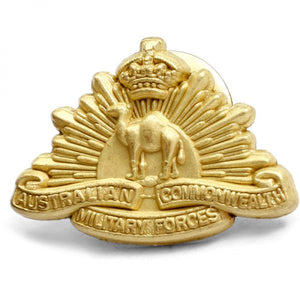Chauvel and the Camel Corps

Earlier this year journalist Sally Cripps joined us for our Living History Day. She shared about her great uncle and great great uncle, General Sir Harry Chauvel and the special connection to the animals here at our farm – which completes what is a nice circle between Summer Land, camels and the Chauvel family.
Australia’s Light Horsemen fought without their horses at Gallipoli but they were reunited with them in Egypt when they were evacuated from that futile conflict.
The generals had to rearrange the forces they had available and the survivors became part of the Egyptian Expeditionary Force, comprised of British infantry and cavalry, as well as many thousands of Anzac horsemen.
The Anzac Mounted Division, formed in March 1916, under the command of Major-General Harry Chauvel was part of this.
The advantages of camels in a desert environment are well known and they’d been used in war efforts for centuries.
The Imperial Camel Corp
The Imperial Camel Corps, a camel-mounted infantry brigade, was raised in January 1916 and was attached to the Anzac Mounted Division, and therefore Harry Chauvel, who commanded the whole division.
The brigade had one battalion each from Great Britain and New Zealand, and two from Australia. It started small but eventually grew to a strength of 3380 men and 3880 camels -500 camels than men.
India supplied the first camels, which were later used as draught animals when the lighter Egyptian camels became the mount chosen for carrying troops. The camels also transported the large amounts of water needed by soldiers, and helped evacuate the wounded from desert situations.
The camels could cover an average distance of 4.8 km an hour, or 9.7 km an hour trotting while carrying a soldier, his equipment, and supplies.
The four companies were expected to operate as independent units that travelled by camel but then dismounted to fight as infantrymen, just as the Light Horse troops did.
Just like the mounted infantry units, one man of each group of four held the camels when the team was in action, which reduced a team’s firepower by a quarter.
However it was soon discovered that camels were not as nervous as horses when faced with artillery and rifle fire, so one man could look after 12 to 16 camels once the troopers had dismounted.
The whole of the Camel Corps was mounted on camels. No wheeled vehicles of any sort were attached. As each man always had to have five days’ supply of food and water for himself, and a similar supply of grain for his mount as well as over two hundred rounds of ammunition, the whole Brigade could, at an hour’s notice, go off into the blue for five days without any communication with or assistance from its base.
The Camel Corps started off being asked to make along patrols in the Western Desert in 1916, with only brief skirmishes with horsemen, but after demonstrating their fighting qualities, the corps was transferred to the Sinai Desert in late 1916, to take part in operations against the Turkish army.

The battalions of the ICC fought alongside Australian light horse units at Romani, Magdhaba and Rafa, and remained an integral part of the force that advanced north through Palestine in 1917 and 1918.
It suffered particularly heavily during the Second Battle of Gaza in April 1917, and in the operations conducted in November to destroy the Turkish defensive line between Gaza and Beersheba, after the famous Light Horse charge at Beersheba that turned the course of the war.
The Imperial Camel Corps had the distinction of operating in more areas than any other body of troops in the Middle East campaign, including alongside Lawrence’s Arab guerrillas harassing the Hejaz railway.
During the EEF’S rapid push north to take Jerusalem in November and December 1917, under Lieutenant-General Sir Edmund Allenby, they had a particularly arduous time, in action with the leading troops for five weeks without respite, advancing a hundred miles against stiff opposition.
For days at a time the camels could not be unsaddled, so that by the new year they were manged and badly needing rest
The men of the ICC had a rough reputation, largely because when the corps was originally formed, Australian battalion commanders had seized upon it as an opportunity to offload some of their more difficult characters.
In 1917 a British supply dump at Rafa was warned to double its guards as the ICC was going to be camped nearby.
The men of the ICC were very resourceful and effective. While defending a hill called Musallabeh in April 1918, some Australians of the ICC ran out of hand grenades.
They resorted to heaving boulders down upon the attacking Turks and eventually fought them off. The hill became known as the “Camel’s Hump”.
As the ICC moved into the more fertile country of northern Palestine, its practicality declined.
The camels needed more fodder and water than equivalent numbers of horses and unimpeded by the desert, horses could move much faster.
The bulk of the ICC was disbanded in June 1918 and the Australians were used to form the 14thand 15thLight Horse regiments.
You might be wondering what happened to the camels. They were originally going to be handed over to the Camel Transport Corps but Lawrence of Arabia convinced Lieutenant-General Allenby that they would be put to better use by the Arab Army.
Just as the Light Horsemen loved their horses and were sorry to part with them, I found some words by trooper Frank Reid, from the 3rd battalion, Imperial Camel Corps, that showed they felt the same way. This is what he wrote:
We were sorry for the camels. Although we often cursed them, when they were to be taken from us, we found that we had become quite attached to our ugly ungainly mounts. The Arabs would not treat them as kindly as we had done, and we reckoned they were entitled to a long spell in country that suited them better than the rough and slippery mountain tracks of Palestine.
In the two years that the Camel Corps was in existence, it lost 240 men, 106 British, 84 Australians, 41 New Zealanders, and nine men from India. I’ve searched for the number of camels that died during the war but it seems to be an unknown quantity. However, it has been estimated that in excess of a million camels were lost during World War One.

The ICC’s main commemorative memorial was unveiled in 1921 on the Thames Embankment in London, where you can visit it today.
I thought I would finish with an article printed in the Melbourne Argus in 1937, that talks about how the regiments that contained the ex-cameliers got their badges, because it shows a wonderful link between Harry Chauvel and the Camel Corps.
I’m going to paraphrase a lot because it was written in the language of the times.
One old camelier was looking at a display of regimental badges in the Argus window wondering what his was, and just happened to be standing beside Sir Harry Chauvel at the time.
The general explained how the badges had evolved. The members of the corps came from all over the Commonwealth so there was no geographic basis to work with when they were assigning them to regiment.
What they did was put most of those from southern Queensland into the 14th while the 15thwas the one where most of the soldiers came from the NSW Northern Rivers district.
The Moreton troop was raised by Colonel Percy Ricardo in 1885 while the Darling Downs one was raised by three men, Colonel HV King of Gowne, Captain Macaush of Canning Downs near Warwick, and Lieutenant HG Chauvel of Canning Downs South.
It was found that the 15thhad the same badge as another and older New South Wales regiment and so they were instructed to apply for another badge.
The commanding officer, a former camelier, consulted Chauvel, his honorary colonel, who suggested taking advantage of both his command of the Desert Mounted Corps plus his own family connection with the regiment, which was raised as the Upper Clarence Light Horse by his father, Major CHE Chauvel of Tabulam, in 1885-6. It was in this regiment that Sir Harry took his first commission.
So, the badge includes a date pair, which was the crest or badge of the Desert Mounted Corps, and two crescents which are taken from the coat of arms of Sir Harry Chauvels father.
The motto is “Nomina Desertis Inscripsimus” – In the Desert We Have Written Our Names.

ABOUT SALLY CRIPPS
Based in Blackall, Qld, Sally is a senior journalist for Queensland Country Life. Sally’s great uncle, Charles Chauvel, was a pioneer in the early Australian film industry who grew up at ‘Summerlands’ (Now Summer Land Camels). Her great great uncle, Sir Harry Chauvel, was a senior officer of the Australian Imperial Force who fought at Gallipoli and during the Sinai and Palestine Campaign in the Middle Eastern theatre of the First World War. He was the first Australian to attain the rank of lieutenant general and later general, and the first to lead a corps. As commander of the Desert Mounted Corps, he was responsible for one of the most decisive victories and fastest pursuits in military history.

